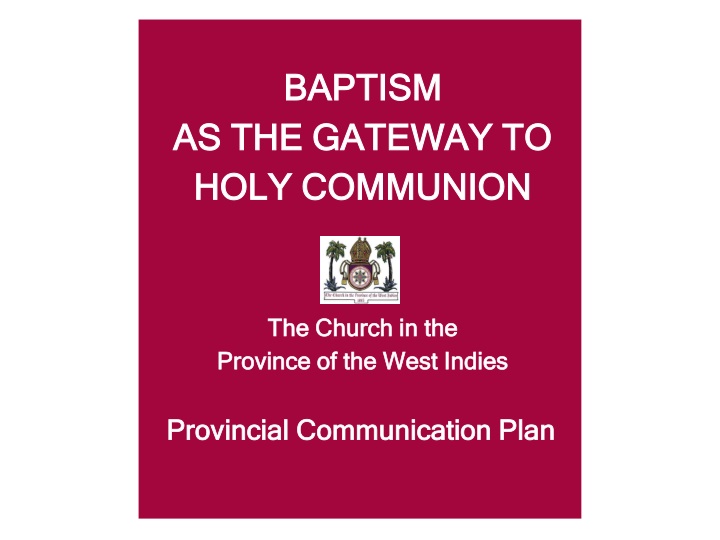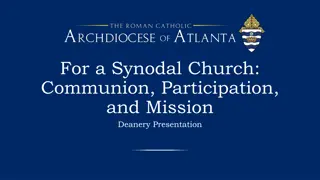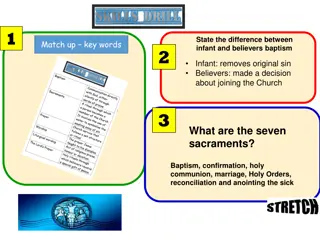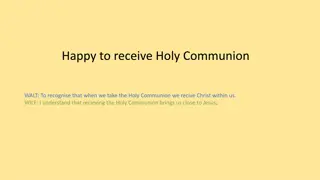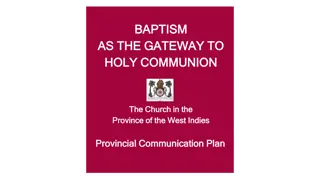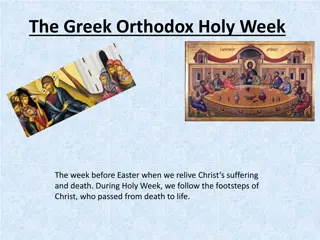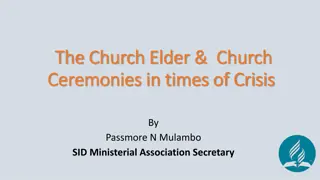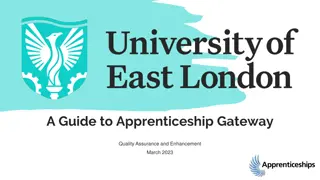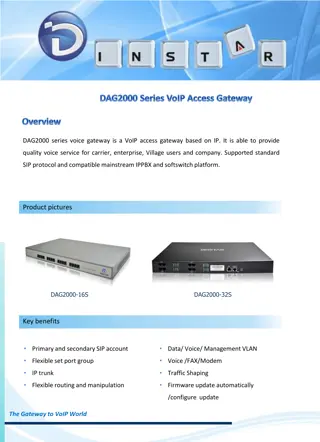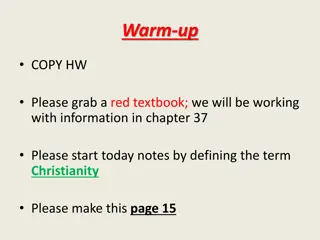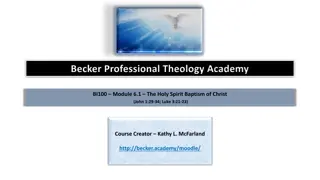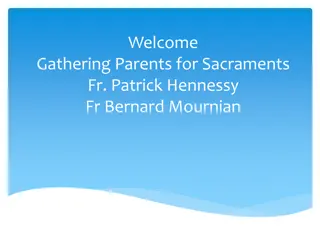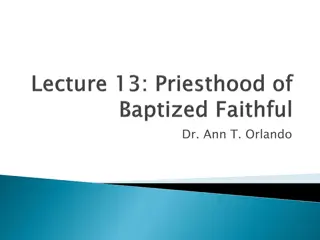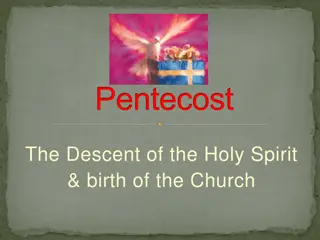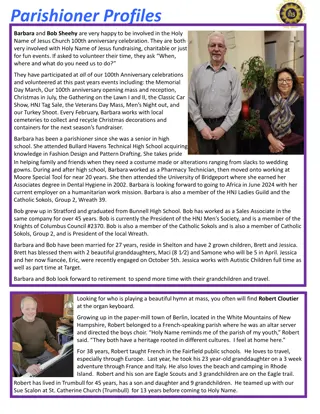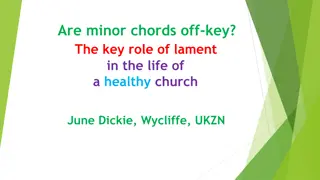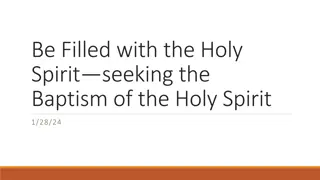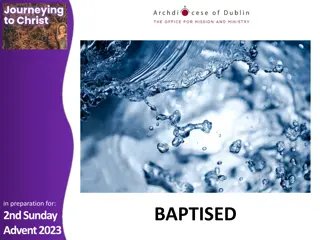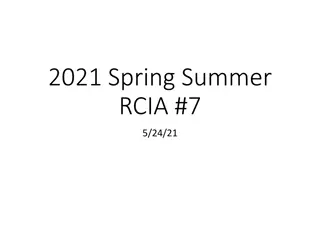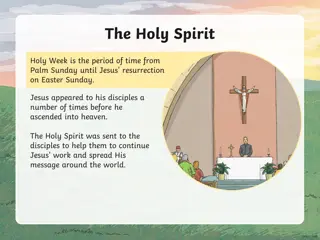Baptism as the Gateway to Holy Communion in Church History
The historical significance of baptism as the gateway to holy communion in the early Church, spanning from the 1st to the 7th century. Discover the practice of infant communion and the evolution of confirmation in relation to this sacred tradition.
Download Presentation

Please find below an Image/Link to download the presentation.
The content on the website is provided AS IS for your information and personal use only. It may not be sold, licensed, or shared on other websites without obtaining consent from the author.If you encounter any issues during the download, it is possible that the publisher has removed the file from their server.
You are allowed to download the files provided on this website for personal or commercial use, subject to the condition that they are used lawfully. All files are the property of their respective owners.
The content on the website is provided AS IS for your information and personal use only. It may not be sold, licensed, or shared on other websites without obtaining consent from the author.
E N D
Presentation Transcript
BAPTISM BAPTISM AS THE GATEWAY TO AS THE GATEWAY TO HOLY COMMUNION HOLY COMMUNION The Church in the The Church in the Province of the West Indies Province of the West Indies Provincial Communication Plan Provincial Communication Plan
Presentation on Baptism as the Gateway to Holy Communion
Organisation of the Presentation 1. Early Church Practice of Baptism as the Gateway to Holy Communion 2. Development of Confirmation 3. Confirmation as the Gateway to Holy Communion 4. Returning to the Early Church Practice: Communication Plan for Preparing our Province for this change
Early Church Practice of Baptism as Early Church Practice of Baptism as the Gateway to Holy Communion the Gateway to Holy Communion
History of Baptism and Holy Communion History of Baptism and Holy Communion 1st Century Church Baptism as the Gateway: According to the Didache (one of the oldest Christian documents), those who are not baptized in the Lord s name are forbidden from participating in the Holy Eucharist. Catechumenate: Tertullian speaks of a detailed and extensive preparation of candidates for baptism which could last for up to three years. Form of Baptism: The form of baptism is to be that which utilizes the Trinitarian formula, thus water was to be poured thrice upon the candidate s head in the name of the Father, Son, and Holy Spirit . (Baptism as the Gateway to Holy Communion Compiled document pg. 37)
Holy Communion to Infants 2nd Century Infants receive Holy Communion in the Western Church 3rd Century Infants receive Holy Communion in Northern Africa 4Th Century Sicily recorded that an eighteen-month-old received the Eucharist and the Fourth Century Apostolic Constitution referred to babes in arms taking the Bread and Wine as well. 7Th Century liturgical text, the ORDOROMANUS XI and a 12th Century Roman pontifical both gave instructions presuming that nursing infants would receive communion. The Gregorian Sacramentary required explicitly that infants be communicated immediately after their baptisms, and Elfric of York ordered his clergy to give newly baptized infants the Eucharist. (Baptism as the Gateway to Holy Communion Compiled document page 49)
Holy Communion to Infants IN ANGLICANISM: 16th and 17th Century Debates in England between those who practiced infant baptism and those who insisted on believer s baptism. Jeremy Taylor even argued that infants should be given both sacraments or none. 18th Century Infant communion was practiced by Non-jurors (A non-juror is a person who refuses to swear a particular oath: In British history, non-jurors refused to swear allegiance to William and Mary and their heirs), as part of their recovery of ancient liturgical practices. (Baptism as the Gateway to Holy Communion Compiled document page 49)
Withdrawal of Holy Communion from Infants Withdrawal of Holy Communion from Infants The withdrawal happened in stages in the 11th and 12th centuries It had nothing to do with knowledge or confirmation. Reasons: 1. The difficulty experienced by some infants in fully swallowing the consecrated Bread led to the practice of giving infants only the cup. 2. When the practice of giving the laity the consecrated wine gradually ceased over the course of the 11th and 12th centuries it had the incidental effect of eliminating the one kind in which infants received. (Baptism as the Gateway to Holy Communion Compiled document page 49)
Age of Discretion/ Understanding 13th Century - pious traditions arose about the need to have reached the age of discretion before communion, but this was not the cause of the end of infant communion. It was the teaching of Thomas Aquinas which influenced the Councils of Florence and Trent and led to the decision. He wrote of aetas perfecta 'perfect age', when the person acquired a certain dignity. (Baptism as the Gateway to Holy Communion Compiled document pages 49-50)
Development of Confirmation Initially the rite of confirmation was not distinct from baptism 1st and 2nd Centuries In the Didache (first century) and the Shepherd of Hermas (second century) only baptism is mentioned as an initiation rite. 4th Century The word 'sphragis; signaculum' was used to indicate seal, as used in confirmation, which was distinct from baptism at that time. Middle Ages The hand laying and anointing became a separate rite of confirmation. (Baptism as the Gateway to Holy Communion Compiled document page 50)
Explanations for the need for Confirmation (Hand Explanations for the need for Confirmation (Hand- -laying & Anointing) laying & Anointing) The Council of Elvira (Spain) about 300, referred to emergency baptism of ailing ship- bound catechumen by a faithful one. If the person recovered, they were to 'be made perfect by the imposition of hands' by the bishop. The Synod of Arles (314) convened by Constantine to address the issue of rebaptism of heretics, concluded that the individual, questioned about the creed, and being previously baptized using the trinitarian formula should then only have hands laid on them to receive the Holy Spirit. The Council of Orange (441) made specific reference to confirmation. In the fifth century in Gaul, the confirmation rite involved the imposition of hands. There could also be anointing with oil but only if the priest baptized in the absence of the bishop and the candidate not receiving chrismation.
Explanations for the need for Confirmation Explanations for the need for Confirmation (Hand (Hand- -laying & Anointing) laying & Anointing) The Second Council of Lyons was the second general council to mention confirmation. The bishop conferred confirmation by the imposition of hands and anointing of those who were reborn. Confirmation occurred immediately after baptism and before Eucharist. The bull Exultate Deo, a part of the decrees of the Council of Florence (1438-1445), indicated that the sacrament was given for strength. The Council of Trent (1545) indicated that like baptism and holy orders, confirmation imprinted a 'character of soul . However, The Roman Catholic Church never mandated confirmation as the gateway to the reception of Holy Communion. (Baptism as the Gateway to Holy Communion Compiled document pages 50-51)
Confirmation as the Gateway: Anglicanism Confirmation as the Gateway: Anglicanism When John Peckham became archbishop of Canterbury in the thirteenth century, he wanted to bring the English Church more in line with Rome. To exercise greater control over the congregations, he insisted that no one should receive the Sacrament unless he or she had been confirmed by a bishop. This was a clever means to give bishops more power in the congregations. The bishop had to visit the congregation in order to confirm so that the people could receive the sacrament. But as Charles P. Price points out in an issue of Occasional Papers, published by the Standing Liturgical Commission, the good bishop s intent was to encourage confirmation by his bishops and not to exclude persons from the communion. Joseph P. Russell and Jane L. Weaver, Children in the Eucharist (Education for Mission and Ministry, Episcopal Church Center, 1990), 7. (Baptism as the Gateway to Holy Communion Compiled document page 51)
Returning to the Early Church Returning to the Early Church Practice of Baptism as the Practice of Baptism as the Gateway to Holy Communion Gateway to Holy Communion
Resolution of the Provincial Synod Resolution of the Provincial Synod May 2019 May 2019 Proposed a return to the Early Church Proposed a return to the Early Church practice of Baptism as the Gateway to practice of Baptism as the Gateway to Holy Communion and mandated a Holy Communion and mandated a period of teaching on Baptism, Faith period of teaching on Baptism, Faith Formation and the Spiritual Disciplines Formation and the Spiritual Disciplines
CPWI Plan for Communicating Policy Change CPWI Plan for Communicating Policy Change Our Vision: Every member becoming fully educated about Baptism and the policy change with regards to receiving Holy Communion Our Goals: To ensure the dissemination of information in a clear and straightforward manner To convey information about the change in policy regarding Baptism as the gateway to Holy Communion. That Baptism will become the only requirement for receiving Holy Communion in the CPWI.
CPWI Plan for Communicating Policy Change CPWI Plan for Communicating Policy Change Our Target Group Overall: Every member of the congregations in the Province of the West Indies 1. Bishops 2. Clergy and Licensed Church Workers 3. Members 3.1 Parents 3.2 Children 3.3 Sunday School Teachers
CPWI Plan for Communicating Policy Change CPWI Plan for Communicating Policy Change How: Diocesan Communication Team Each Diocese should establish a communication team to craft and implement the Diocesan plan for communicating the policy change Diocesan Communication teams will be responsible for: 1. Establishing online access to all promotional material or pointing to Provincial online resources 2. Production of Diocesan Promotional Resources/ or use of Provincial resources (Videos, posters, flyers, booklets) 3. Organize Promotional/ Engagement Events for key stakeholders
Stage 1 Stage 1 Getting the Getting the Word Out Word Out
Avenues of Communication Avenues of Communication 1.Promotional Videos Method Presenter Target Initial Promotional Video The Archbishop All members of the Province Promotional Videos Diocesan All members of each Diocese Bishops
Avenues of Communication: Promotional Videos Avenues of Communication: Promotional Videos Goals: The Promotional Videos will: State the change Outline possible effects of the change Outline the Plan for teaching Encourage participation Access: All promotional videos to be made available on the CPWI website and where applicable on individual Diocesan websites A specific website can be created to host the material if there is a concern that Diocesan websites are overcrowded. In that case, a link would be made available and prominently displayed on the Diocesan websites or leading to the Provincial website.
Avenues of Communication Avenues of Communication 2. Discussion Event with Members of Clergy and Licensed Church Workers (Recognizing that some provisional discussions may have taken place) Goals: i. Discuss the policy change ii. Discuss the impact on admission to Holy Communion and The impact on Confirmation iii. Convey communication/teaching strategies to share the policy change iv. Provision of an information packet
Avenues of Communication: Discussion Event Avenues of Communication: Discussion Event Each Diocese will set aside a date and plan an event to share with Members of Clergy and Licensed Church Workers. This in-person or virtual event to be led by the Diocesan bishop and Communication team Materials: Diocesan Promotional Videos Bible Study Baptism information booklet Baptism Sunday School packet History of Confirmation information booklet
Avenues of Communication Avenues of Communication 3. Launch Posters and Flyers Competitions Goals: To state the change provide a quick, short answer format to potential questions for each Diocese Background: Each Diocese is unique and may choose to create their own or use the Provincial material. If each has an input in the creation of the resources, it will increase their involvement and ownership of the process of disseminating the information
Avenues of Communication: Avenues of Communication: Posters and Flyers Competition Posters and Flyers Competition Note: The creation of the posters/ flyers can become an activity for children, youth groups, church groups The basic information for the posters and flyers would be provided, and the instructions for submission of entries can be completed by each Diocese Access: To be displayed on websites (Provincial and Diocesan) and printed
Avenues of Communication Avenues of Communication 4. Launch Diocesan Sunday School Resources Goal: To Provide resources for Sunday School teachers to use to teach students about Baptism and Holy Communion Target: Members of Clergy and Licensed Church Workers Sunday School Teachers Parents Sunday School Students
Avenues of Communication: Avenues of Communication: Diocesan Sunday School Resources Diocesan Sunday School Resources Each Diocese will set aside a date/s to engage the stakeholders of the Sunday School to discuss the impact of the policy change and the resources being made available Resources: Diocesan Guidelines for Implementation of Policy Change for Teachers, Parents, and children Sunday School Curriculum for teaching about Baptism Background information on Baptism for teachers Covenant for parental involvement Sunday School events for engaging students VBS, Competitions, Bible Study
Stage 2 Stage 2 TEACHING TEACHING TIME TIME
Teaching Series: Teaching Series: Each Diocesan Communication Team will organize teaching series using suitable methodologies to engage key stakeholders. Initially, the focus will be on Members of Clergy and Licensed Church Workers as well as Sunday School teachers because these are the trainers who will deliver the content at the local level in the congregations to both adults and children Provincial Master Teachers could be engaged to provide recorded lectures or online interactive presentations so that all Dioceses would have equal access to resource persons.
Teaching Series: Training the Trainers Teaching Series: Training the Trainers Target: Members of Clergy and Licensed Church Workers: Topics: 1. What is Baptism Theology of Baptism 2. What is Holy Communion 3. History of Confirmation 4. Why the need for a change to Baptism as the gateway to Holy Communion 5. How to engage families in determining that their child/ ward is ready to receive Holy Communion 6. How to engage the wider church in understanding Baptism, Holy Communion and Confirmation 7. How to teach Sunday School teachers to engage children in understanding Baptism
Teaching Series: Training the Trainers Teaching Series: Training the Trainers Target: Sunday School Teachers: Topics: 1. What is Baptism Theology of Baptism 2. What is Holy Communion 3. History of Confirmation 4. Why the need for a change to Baptism as the gateway to Holy Communion 5. How to teach the Sunday School lessons on Baptism 6. How to engage children and parents in a discussion about receiving Holy Communion
TEACHING TEACHING RESOURCES RESOURCES
Resources Note: Resources Note: Specific resources will be made available to their target group. However, all will be made available online at the Provincial website (for Provincial Resources) and Diocesan websites for specific Diocesan resources. Alternately: As Dioceses craft their specific resources, these could be made available and labeled for each Diocese on the Provincial website. This will ensure that all resources can be accessed by everyone across the Province. This will enable the sharing of resources as well. Specific Resources have been produced in triplicate for three target groups: Standard - Text which has not been simplified Simplified Text (Adult) Paraphrased text for adults Simplified Text (Child) Paraphrased text for children
List of Resources List of Resources 1. Baptism as the Gateway short answer leaflet (Policy Background Information) Produced in Triplicate + 2. Exploring Baptismal Theology + 3. Baptism as the Gateway with History of Confirmation booklet + 4. Provincial Guidelines on Baptism as the Gateway to Holy Communion (For Church members) 5. Provincial Guidelines on Baptism as the Gateway to Holy Communion (For Clergy and Licensed Church Workers) 6. Provincial Guidelines on Baptism as the Gateway to Holy Communion (For Teachers, Parents, and Children) 7. Bible Study Guide on Baptism 8. Sunday School Curriculum: Baptism (containing lesson plans, resource materials, background information) 9. What every Parent should know and teach their child about Baptism (Covenant document) 10. When is your child ready for Holy Communion Booklet 11. Teach me about Holy Communion (Children s Guide) 12. Flyers & Posters Key: + Core Resources. See Appendix 1 for Completed Document Concept Document. See Appendix 2
Resources Recommended For Members of Resources Recommended For Members of Clergy and Licensed Church Workers: Clergy and Licensed Church Workers: 1. Provincial Guidelines on Baptism as the Gateway to Holy Communion (For Church members) 2. Provincial Guidelines on Baptism as the Gateway to Holy Communion (For Clergy and Licensed Church Workers) 3. Provincial Guidelines on Baptism as the Gateway to Holy Communion (For Teachers, Parents, and Children) 4. Baptism as the Gateway short answer leaflet (Policy Background Information) 5. Exploring Baptismal Theology 6. Baptism as the Gateway with History of Confirmation booklet 7. Bible Study Guide on Baptism 8. Sunday School Curriculum: Baptism (containing lesson plans, resource materials, background information) 9. What every Parent should know and teach their child about Baptism (Covenant document) 10. When is your child ready for Holy Communion Booklet 11. Teach me about Holy Communion (Children s Guide) 12. Flyers & Posters
Resources Recommended For Church Resources Recommended For Church Members: Members: 1. Provincial Guidelines on Baptism as the Gateway to Holy Communion (For Church members) 2. Baptism as the Gateway short answer leaflet (Policy Background Information) 3. Baptism as the Gateway with History of Confirmation booklet 4. Bible Study Guide on Baptism 5. Flyers & Posters
Resources Recommended For Sunday Resources Recommended For Sunday School Teachers: School Teachers: 1. Provincial Guidelines on Baptism as the Gateway to Holy Communion (For Church members) 2. Provincial Guidelines on Baptism as the Gateway to Holy Communion (For Teachers, Parents, and Children) 3. Baptism as the Gateway short answer leaflet (Policy Background Information) 4. Baptism as the Gateway with History of Confirmation booklet 5. Sunday School Curriculum: Baptism (containing lesson plans, resource materials, background information) 6. Flyers & Posters
Resources Recommended For Parents and Resources Recommended For Parents and Guardians: Guardians: 1. Provincial Guidelines on Baptism as the Gateway to Holy Communion (For Congregants) 2. Provincial Guidelines on Baptism as the Gateway to Holy Communion (For Teachers, Parents, and Children) 3. Baptism as the Gateway short answer leaflet (Policy Background Information) 4. Baptism as the Gateway with History of Confirmation booklet 5. Sunday School Curriculum: Baptism (containing lesson plans, resource materials, background information 6. What every Parent should know and teach their child about Baptism (Covenant document) 7. When is your child ready for Holy Communion Booklet 8. Flyers & Posters
Resources Recommended For Children Resources Recommended For Children and Youth: and Youth: 1. Provincial Guidelines on Baptism as the Gateway to Holy Communion (For Church members) 2. Provincial Guidelines on Baptism as the Gateway to Holy Communion (For Teachers, Parents, and Children) 3. Sunday School Curriculum: Baptism (containing lesson plans, resource materials, background information) 4. Teach me about Holy Communion (Children s Guide) 5. Flyers & Posters
Communication Plan: Summary Communication Plan: Summary The Vison of the Communication plan is for every member of the Province becoming fully educated about Baptism and the policy change of Baptism being the only requirement for receiving Holy Communion. Through the different strategies and resources, we hope to effectively disseminate information on the policy change in a clear and straightforward manner. The Plan envisions partnerships among key stakeholders: Bishops, Members of Clergy and Licensed Church Workers, Sunday School Teachers, Congregants, Parents, and children Diocesan Communication Teams will also be required to coordinate the activities being proposed.
The Plan is divided into three main sections: Getting the Word Out, Teaching Time and Teaching Resources
1. Getting the Word Out: 1. Getting the Word Out: This is the promotion phase of the Plan. Promotional videos, discussion events, event launches to promote posters and flyers, and Sunday School Resources will be used to ensure that: All members of the Province hear that there will be a policy change, what it will be and when it will become effective.
2. Teaching Time: 2. Teaching Time: The Plan requires teaching about Baptism and the impact of the Policy change to Baptism as the Gateway to Holy Communion. Diocesan Communication Teams will be required to organize sessions to target the main stakeholders who will actually teach in the local congregations, i.e., Members of clergy and Licensed Church Workers and Sunday School Teachers.
Teaching Topics Teaching Topics Topics Include: 1. What is Baptism Theology of Baptism 2. What is Holy Communion 3. History of Confirmation 4. Why the need for a change to Baptism as the gateway to Holy Communion 5. How to engage families in determining that their child/ ward is ready to receive Holy Communion 6. How to engage the wider church in understanding Baptism, Holy Communion and Confirmation 7. How to teach Sunday School teachers to engage children in understanding Baptism Members of clergy and Licensed Church Workers would be encouraged to share at the local congregation level both to the wider church family and specifically to parents and children. Sunday School teachers would share with parents and students.
3. Teaching Resources: 3. Teaching Resources: For the Communication Plan to be effective, there must be supporting resources that are agreed upon and accessible across the Province. Suggested material is presented to meet the needs of the proposed stakeholders. The resources have been divided into two Appendices: Appendix 1: Core Documents These are the primary teaching documents. They contain the Provincial position on the topics of Baptism and Holy Communion. Additional information on the history of confirmation is also provided. The complete documents are provided. Appendix 2: Concept Documents These are proposal documents that have been crafted using the Core Documents to address some anticipated issues and questions. Excerpts of these documents have been provided to give an idea of the content.
Core Documents: Appendix 1 Core Documents: Appendix 1 1. Baptism as the Gateway short answer leaflet (Policy Background Information) Produced in Triplicate 2. Exploring Baptismal Theology 3. Baptism as the Gateway with History of Confirmation booklet
Concept Documents: Appendix 2 Concept Documents: Appendix 2 1. Provincial Guidelines on Baptism as the Gateway to Holy Communion (For Church members) 2. Provincial Guidelines on Baptism as the Gateway to Holy Communion (For Clergy and Licensed Church Workers) 3. Provincial Guidelines on Baptism as the Gateway to Holy Communion (For Teachers, Parents, and Children) 4. Bible Study Guide on Baptism 5. Sunday School Curriculum: Baptism (containing lesson plans, resource materials, background information) 6. What every Parent should know and teach their child about Baptism (Covenant document) 7. When is your child ready for Holy Communion Booklet 8. Teach me about Holy Communion (Children s Guide) 9. Flyers & Posters
BAPTISM BAPTISM AS THE GATEWAY TO AS THE GATEWAY TO HOLY COMMUNION HOLY COMMUNION The Church in the The Church in the Province of the West Indies Province of the West Indies Provincial Communication Plan Provincial Communication Plan
Baptism as the Gateway to Holy Communion short answer leaflet
1. What change is being proposed by the Provincial Synod? The Resolution passed at the Provincial Synod outlined what is being proposed to congregations: WHEREAS the House of Bishops of the Church in the Province of the West Indies, after a process of reflection on the history and theology inherent in the rites of Christian Initiation and the practices related to admission to Holy Communion, have unanimously agreed to return to the early practice of Christian Initiation inclusive of making Baptism the gateway to Holy Communion; AND WHEREAS the House of Bishops have given the assurance that this return to the early practice will only be enforced after an extensive process of teaching and communication at parish level focusing on formation in faith? formation in worship and formation in spiritual disciplines; BE IT HEREBY RESOLVED that this Fortieth Session of Provincial synod of the Church in the Province of the West Indies with the decision of the House of Bishops to make Baptism the gateway to communion provided that change in present practice will only occur after a transition resolution by the House of Bishops and subsequently passed by the Provincial Synod.
